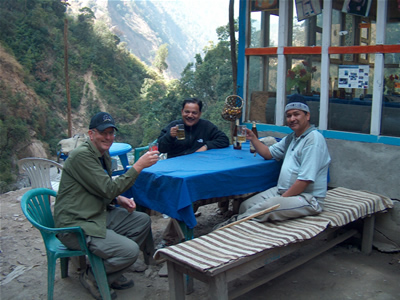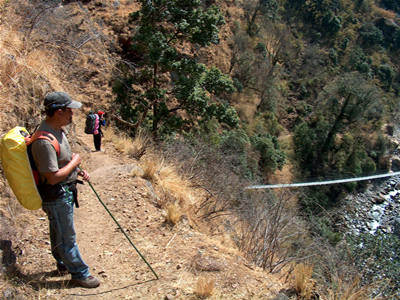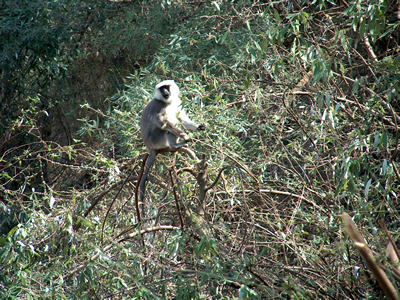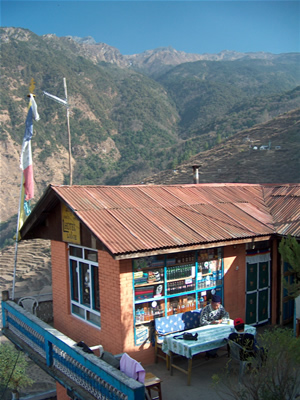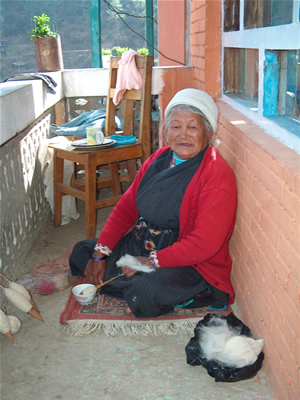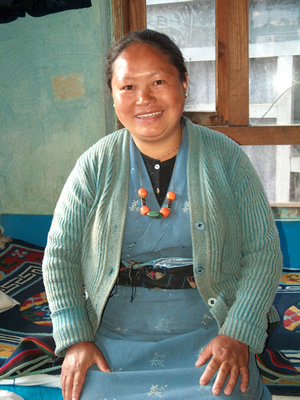Gosaikund Lakes
The first part of the trek had been in Langtang National Park. Although there are no 8000 meter peaks in Langtang, the mountains are still higher than any outside of Asia and the scenery is spectacular. It was similar to my two previous treks in the Everest and Annapurna regions. The second part of the trek would be different as the attraction would be more the culture of the local people than spectacular scenery (although the area was still very beautiful). Our main destination would be the Gosaikund Lakes. These are high mountain lakes near the crest of the mountains to the south of the Langtang Valley. It is one of the most sacred places in all of Nepal for Hindus and it is revered by Buddhists as well. Thousands of pilgrims travel to the lakes for the festival of Janai Purnima, known in English as the Full Moon Shamanism festival. It is held every August on, wait for it, the night of the full moon. High caste Hindus emulate Lord Shiva by bathing in the lake. Since the main lake is at an altitude of 4315 meters (14,156 feet) the water in it is pretty darn cold. I can believe that they have a religious experience when they dive in. Hindus believe that the lakes were formed when Shiva thrust his trident into the mountain to find water.
Beyond the Gosaikund Lakes is the Helambu district. It is one of the main homes of the Tamang people of Nepal, probably the most famous of the Himalayan mountain peoples after the Sherpas. Trekking in Helambu is also more of an opportunity to see the culture of the local people than to see spectacular mountains. Both Tasi and Khim are Tamang, as were all but one of the Nepalis on my Annapurna trek last year.
From Lama Hotel we still had to descend further down the valley of the Langtang Khola until we reached the trail to Syabru. From the trail junction we would be climbing for three straight days until we reached 4610 meter Laurabina pass just beyond the Gosaikund Lakes. Knowing that we had all that elevation gain ahead of us it was discouraging to be descending. Such is trekking in Nepal. We only hiked for about three hours before stopping for lunch at 10:30 at the last tea house before the trail junction. There wouldn't be anyplace to stop after that until we reached Syabru at the end of the day. So it was time for lunch.
That morning I had seen two Nepalis on the trail who seemed more like tourists than locals. They were middle-aged men who were dressed like westerners (but not like trekkers) and had another young Nepali carrying their pack for them. One of them had a digital camera and was snapping photos. They also stopped at the same tea house as us but they ordered beer instead of lunch. At 10:30 in the morning, with hard hiking and altitude to think about, I decided that they were a lot tougher than I was. But soon they invited me to join them and even bought a beer for me. Still a little early by my way of thinking, but as they say, it's happy hour somewhere. I learned that they were civil engineers who worked for the Nepali government. They were inspecting water projects in the area. There is not much of a middle class in Nepal so it was interesting to meet and talk with some professionals. One of them had a son studying electrical engineering at a university in Italy. The other had two children in high school. They were also interested in getting photos so I got their addresses and added them to the list of people I would send pictures to once I got back to Singapore.
As promised, after lunch there was a long climb up out of canyon to the village of Syabru. We just took it slowly so it wasn't too bad. Most of the steep climbing at the beginning was in the forest so the trail was cool and shady. At one point we passed very close to a family of monkeys in a tree and had a good closeup view of them. We finally came out of the forest and could see the village of Syabru across a side valley. It was still quite a lot higher but we had made substantial progress from the bottom of the canyon. Then came the most discouraging part as we had to drop down about 500 feet to cross a side stream and then climb right back up again to where we had been so that we could keep on climbing even higher.
Syabru is set on the crest of a subsidiary ridge descending into the main Langtang Khola canyon. The views from the village are impressive in all directions. Syabru was larger than any of the other villages we had been in and had many lodges. But with the road closure the place was deserted. The only other trekker I saw in the entire village was a European woman that I had met on the trail a few days before. She said that she was staying in Syabru for several days because there was some kind of local festival in town over the weekend that she wanted to see. We would be moving onward and upward the following day of course.
There was a balcony in the back of the lodge that looked out over the mountains. An old woman was sitting there spinning wool into thread. She was out there all afternoon and evening, just making her thread and I guess enjoying the view. I gestured to her to see if she thought that it was ok to take her picture and she was happy to pose.
We spoke to the couple that ran the lodge at dinner and found out that my model was 82 years old and was the woman's mother. She sure seemed like a tough old girl. The lodge keeper asked me to send her the pictures I had taken of her mother. I also took some pictures of them as well. More people on my list that I would be sending pictures when I got back home.
Syabru did have a spectacular setting on the crest of a ridge. To the northeast you could see the Langtang valley with the peaks of the Langtang massif towering overhead. To the southeast was a view of the mountains in the vicinity of the Gosaikund Lakes. We would be climbing further up into those mountains for the next two and a half days. It was beautiful to watch the colors change as the sun went down that night. Then first thing the next morning I was busy taking photos of the Ganesh Himal to the west, taking advantage of the great morning light on those mountains. There was a great view from an open area in front of the village temple that was right across from our lodge. Although I never saw the temple when it was open I had heard chanting and drum beats the previous evening and early in the morning.
Then it was time for breakfast before leaving for the day's hike. Besides the guest rooms, the lodge had two main rooms. A kitchen of course. All Nepali homes seem to have a kitchen as the most important room in the house. Then there was main dining room next to the kitchen which was also the bedroom for the couple that ran the lodge.
When we went into the dining room for breakfast the lady of the house was busy in the kitchen getting our food ready. But her husband was still sacked out and snoring loudly while we sat there talking. After a while he sat up in his bed and scratched his head to wake up. Then he went outside for a minute to wash up before coming back in to chat with us over breakfast. Hospitality is one thing but I prefer to have a little privacy myself. After breakfast we had a photo session and I took a bunch of pictures of everyone with promises to print them and mail them after my return to Singapore. The man spent a long time trying to convince me that I needed to support Nepali children in their village school. It sounded like a really good cause but I was just a little bit skeptical when he told me that the best way to do that would be to send money to him with the photos. I was afraid that this charity might have a high "administrative overhead".
But enough stalling. It was time to get moving. The weather was perfect and it was going to be another beautiful day on the trek. We had a long, hard climb ahead of us on our journey toward the Gosaikund Lakes.
